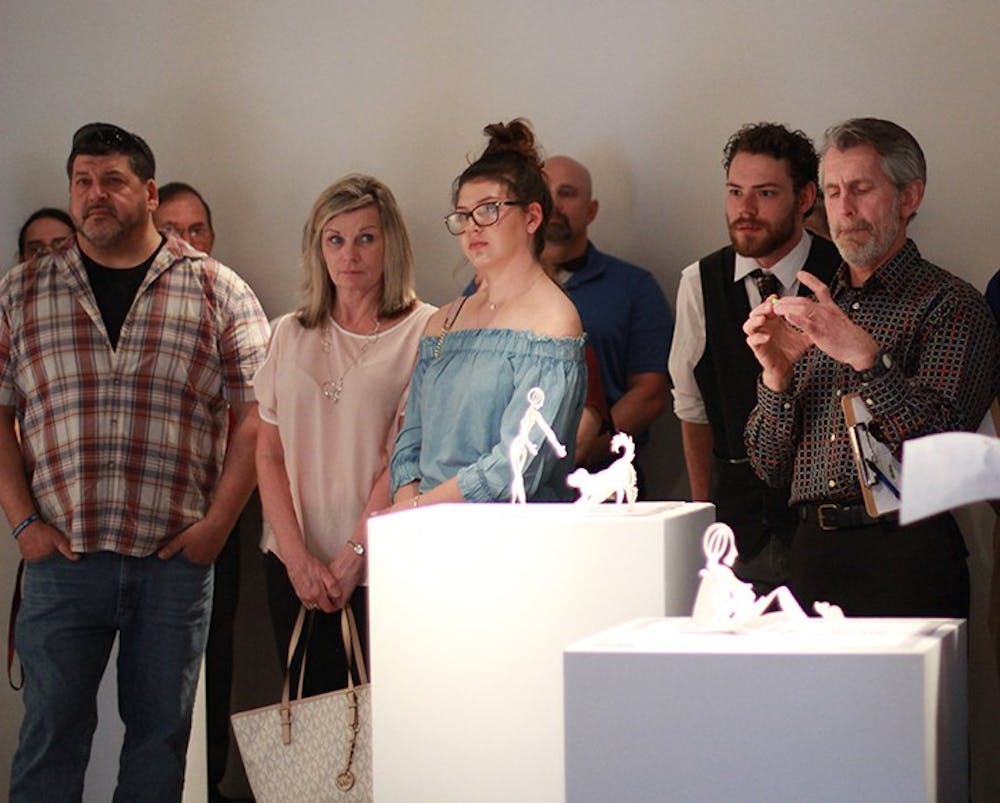The second part of the “SU Senior Exhibition” opened to the public in the Shippensburg University Kauffman Gallery on April 14 in a final send-off for the art and design department’s graduating seniors.
The exhibit allowed the student artists to show off their talent in front of their friends, family and professors in one of their last projects of the semester. The exhibit and the first part of the “SU Senior Exhibition” that ran from March 31–April 6 featured many different styles of art, including sculptures, paintings, drawings and even a video display.
Julie Noel was the first to present her artwork, “Pittura Infamanta,” at the exhibition. The coloration in the collection was intended to reflect the façade that society places over people, Noel said. As the viewer focuses on the images, they look past the mask of vibrant colors placed over the art and recognize the true dimensions of the faces — a decrying of stereotypes.
“This is something we all deal with,” she said.
Laura Weikel was the next to present. Her art, dubbed “Untitled,” was symbolic of her panic attacks. The collection imparted the feeling of being trapped and unable to breathe using a whitewash effect, according to Weikel.
The creation of Takeisha Stitt’s art was a transformative process, which started as a project to form metal sculptures. The sculptures of skeletons and animals interacting were inspired from her best friend from high school who committed suicide.
“I wanted to remember her how she lived,” Stitt said. “I wanted to depict her playing with her animals.”
Dylan Yoos opened his part of the presentation by saying “We are a destructive species.”

Yoos gestured to one of his pieces — a jackrabbit with pieces of a plastic toy tank attached to itself. Meanwhile, a turkey across the room had armed itself with a plastic pistol, as if daring a hunter to try to collect for Thanksgiving dinner. Yoos’ message was of the damaging impact humans have had on so many environments. This has forced animals to either adapt or be killed off.
Catherine Harris’ exhibit, which was titled by dates in her life, was a representation of her struggle with her personal health.
“This is a visual journal, day-by-day,” she told the audience. The collection was filled with watercolor collages that each told a story on their own. Put together, it told the story of her struggle, but also her determination to thrive and succeed.
Liken Sullers used her platform as an artist to express a different side of the abortion story. Her art was inspired by her cousin, who chose to have a child that she could not support. Even though it was a struggle for her as a single parent, she still had the fortitude to love the child.
In each of the panels of the carving, the mother wore different clothes. Sullers said she wanted to show the universality of mother-hood across different cultures. At the end of her presentation, Sullers specifically thanked all mothers for the love they invest into their children.
Halle Shank’s video production exhibit was looped for display in the Brindle Gallery. An ode to her fiancé, a soldier without PTSD, the exhibit focused on what he may have to grapple with someday. Shank decided to center her art on this subject after researching the subject for her own use.
The film itself used visceral imagery and sounds to immerse the viewer in the mind of someone with PTSD. The flashing of light, the inability of the camera to move away from looking at a terrifying scene, and the sound of blood pumping and a clock ticking all contributed to the panic of trauma. The video subtly highlighted many important factors of the mental illness, such as nervous and compulsive ticks, and capitalized on the factor of fear.




The Slate welcomes thoughtful discussion on all of our stories, but please keep comments civil and on-topic. Read our full guidelines here.